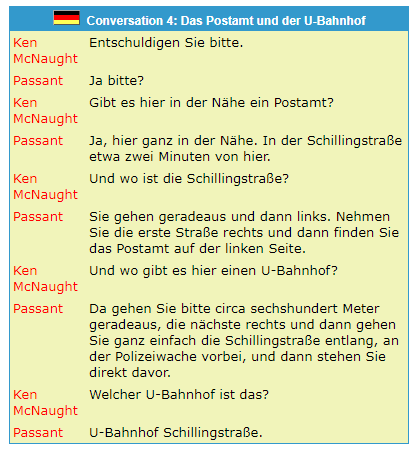Ken McNaught is now positioned "Ecke Singerstraße Neue Blumenstraße", that is on the corner of Singerstraße and Neue Blumenstraße in what used to be East Berlin. He asks a passer-by wher he can find the post-office and the underground station.
Both of these are shown on the map below - the post-office has the yellow logo of the German post office Deutsche Post with its trademark horn, and the "U-Bahnhof" (= "underground station") is indicated by the blue letter "U".

Glossary
hier in der Nähe---near here
hier ganz in der Nähe---very near here
das Postamt---"Post office". You will often hear the word "die Post" used for this, which also means the post office as an institution.
etwa---approximately
zwei Minuten von hier---two minutes from here
Wo gibt es hier einen U-Bahnhof?---"wher is an underground station round here?" As "es gibt" takes the accusative case, the masculine noun "ein U-Bahnhof" becomes "einen U-Bahnhof".
circa approximately; about
sechshundert Meter---six hundred metres
ganz einfach---quite simply
die Schillingstraße entlang---"Along the Schillingstraße". The preposition "entlang" follows the noun to which it refers.
die Polizeiwache---"Police station". It is indicated on German maps by a green star on a white circular background.
an der Polizeiwache vorbei---past the police station
direkt davor directly in front of it
Welcher U-Bahnhof ist das?---"Which underground station is that?" If the noun following "which" was a feminine noun, it would be "welche" and if it was a neuter noun, it would be "welches".
 英语
英语 日语
日语 韩语
韩语 法语
法语 西班牙语
西班牙语 意大利语
意大利语 阿拉伯语
阿拉伯语 葡萄牙语
葡萄牙语 越南语
越南语 俄语
俄语 芬兰语
芬兰语 泰语
泰语 丹麦语
丹麦语 对外汉语
对外汉语

